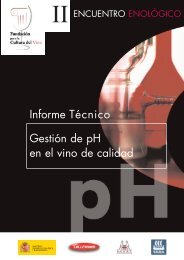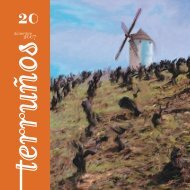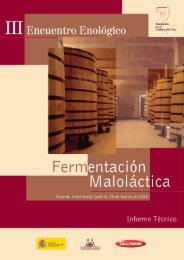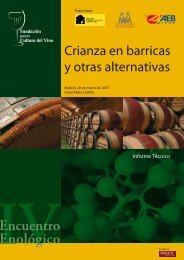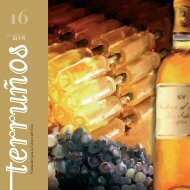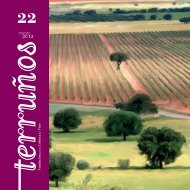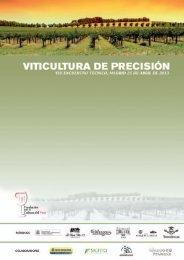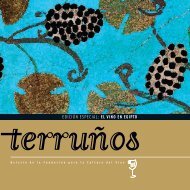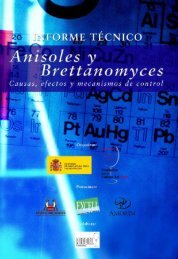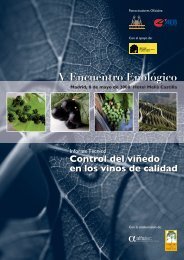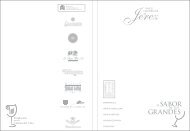Compuestos azufrados volátiles en vinos - Fundación para la ...
Compuestos azufrados volátiles en vinos - Fundación para la ...
Compuestos azufrados volátiles en vinos - Fundación para la ...
You also want an ePaper? Increase the reach of your titles
YUMPU automatically turns print PDFs into web optimized ePapers that Google loves.
Influ<strong>en</strong>ce of the Timing of Nitrog<strong>en</strong> Additions during Synthetic Grape Must Ferm<strong>en</strong>tations on Ferm<strong>en</strong>tation Kinetics and Nitrog<strong>en</strong> ConsumptionHigher alcohols were also affected by the changes innitrog<strong>en</strong> utilization. These compounds can be producedeither by the catabolic conversion of the branched-chainamino acids (via Ehrlich) or by the anabolicformation of these amino acids de novo froma sugar substrate (14, 15). Our results show that theanabolic route is of greater importance because theincrease in isoamyl alcohol and 2-ph<strong>en</strong>yl ethanol wasinversely proportional to the consumption of leucineand ph<strong>en</strong>y<strong>la</strong><strong>la</strong>nine, respectively.Furthermore, the closer the nitrog<strong>en</strong> conc<strong>en</strong>trationis to the growth-limiting level, the higher the yield offusel alcohols is.There is also an inverse corre<strong>la</strong>tion betwe<strong>en</strong> ammoniumconsumption and the production of fusel alcohols(12). A greater conc<strong>en</strong>tration of higher alcoholsdid not seem to determine an increase in esters. Incontrast, the acetate conc<strong>en</strong>tration seemed to determinea greater conc<strong>en</strong>tration of acetate esters, especiallyethyl acetate.In conclusion, our study shows the quantity and qualityof the nitrog<strong>en</strong> demands of the wine strain QA23.Although further studies should be carried out withother wine strains, our data show that cell growthand ferm<strong>en</strong>tation have differ<strong>en</strong>t preferred nitrog<strong>en</strong>sources. Nitrog<strong>en</strong> additions always improved ferm<strong>en</strong>tationperformance but had a minimal effect on biomassproduction wh<strong>en</strong> added in the second half ofthe ferm<strong>en</strong>tation. These nitrog<strong>en</strong> additions subjectedthe cells to NCR and changed the profile of nitrog<strong>en</strong>consumption. The differ<strong>en</strong>ces in the pattern of nitrog<strong>en</strong>consumption were re<strong>la</strong>ted to differ<strong>en</strong>t aromacompound compositions in the wines. In our opinion,this study is a starting point for further investigationinto using an ammonium/amino acid mixture as nitrog<strong>en</strong>supplem<strong>en</strong>tation in the wine industry and theeffect that these additions have on yeast physiology,ferm<strong>en</strong>tation performance, and wine quality.ACKNOWLEDGMENTThis work was supported by grant AGL2000-0205-P4-03 from the Comisión Interministerial deCi<strong>en</strong>cia y Tecnología, Spain.The authors wish to thank the <strong>la</strong>nguage service of theRovira i Virgili University for revising the manuscript.LITERATURE CITED(1) Bisson, L. F. Influ<strong>en</strong>ce of nitrog<strong>en</strong> on yeast and ferm<strong>en</strong>tationof grapes. In Proceedings of the InternationalSymposium on Nitrog<strong>en</strong> in Grapes andWine; Ranz, J. M., Ed.; American Society of Enologyand Viticology: Davis, CA, 1991.(2) Bely, M.; Sab<strong>la</strong>yrolles, J. M.; Barre, P. Automatic detectionof assimi<strong>la</strong>ble nitrog<strong>en</strong> defici<strong>en</strong>cies duringalcoholic ferm<strong>en</strong>tation in o<strong>en</strong>ological conditions.J. Ferm<strong>en</strong>t. Bio<strong>en</strong>g. 1990, 70, 246- 252.(3) Jiranek, V.; Langridge, P.; H<strong>en</strong>schke, P. A. Yeast nitrog<strong>en</strong>demand: selection criterion for wine yeastsfor ferm<strong>en</strong>ting low nitrog<strong>en</strong> musts. In Proceedingsof the International Symposium on Nitrog<strong>en</strong>in Grapes and Wine; Ranz, J. M., Ed.; AmericanSociety of Enology and Viticology: Davis, CA,1991. (4) Monteiro, F. F.; Bisson, L. F. Nitrog<strong>en</strong> supplem<strong>en</strong>tationof grape juice. I. Effect on aminoacid utilization during ferm<strong>en</strong>tation. Am. J. Enol.Vitic. 1992, 43, 1 -1 0.(5) Bely, M.; Sab<strong>la</strong>yrolles, J. M.; Barre, P. Description ofalcoholic ferm<strong>en</strong>tation kinetics: its variability andsignificance. Am. J. Enol. Vitic. 1990, 41, 319-324.(6) M<strong>en</strong>des-Ferreira, A.; M<strong>en</strong>des-Faia, A.; Leao, C.Growth and ferm<strong>en</strong>tation patterns of SaccharomycescereVisiae under differ<strong>en</strong>t ammoniumconc<strong>en</strong>trations and its implications in winemakingindustry. J. Appl. Microbiol. 2004, 97, 540-545.(7) Cooper, T. G. Nitrog<strong>en</strong> metabolism in SaccharomycescereVisiae. In The molecu<strong>la</strong>r Biology of theYeast Saccharomyces; Stratherm, J. N., Jones, E.W., Broach, J. R., Eds.; Cold Spring Harbor Laboratory:Cold Spring Harbor, New York, 1982.(8) ter Schure, E. G.; van Riel, N. A.; Verrips, C. T. The roleof ammonia metabolism in nitrog<strong>en</strong> cataboliterepression in Saccharomyces cereVisiae. FEMSMicrobiol. ReV. 2000, 24, 67- 83.(9) Beltran, G.; Novo, M.; Rozes, N.; Mas, A.; Guil<strong>la</strong>mon,J. M. Nitrog<strong>en</strong> catabolite repression in SaccharomycescereVisiae during wine ferm<strong>en</strong>tations.FEMS Yeast Res. 2004, 4, 625-632.(10) Jiranek, V.; Langridge, P.; H<strong>en</strong>schke, P. A. Regu<strong>la</strong>tionof hydrog<strong>en</strong> sulfide liberation in wine-producingSaccharomyces cereVisiae strains by assimi<strong>la</strong>bl<strong>en</strong>itrog<strong>en</strong>. Appl. EnViron. Microbiol. 1995, 61, 461-467.48



